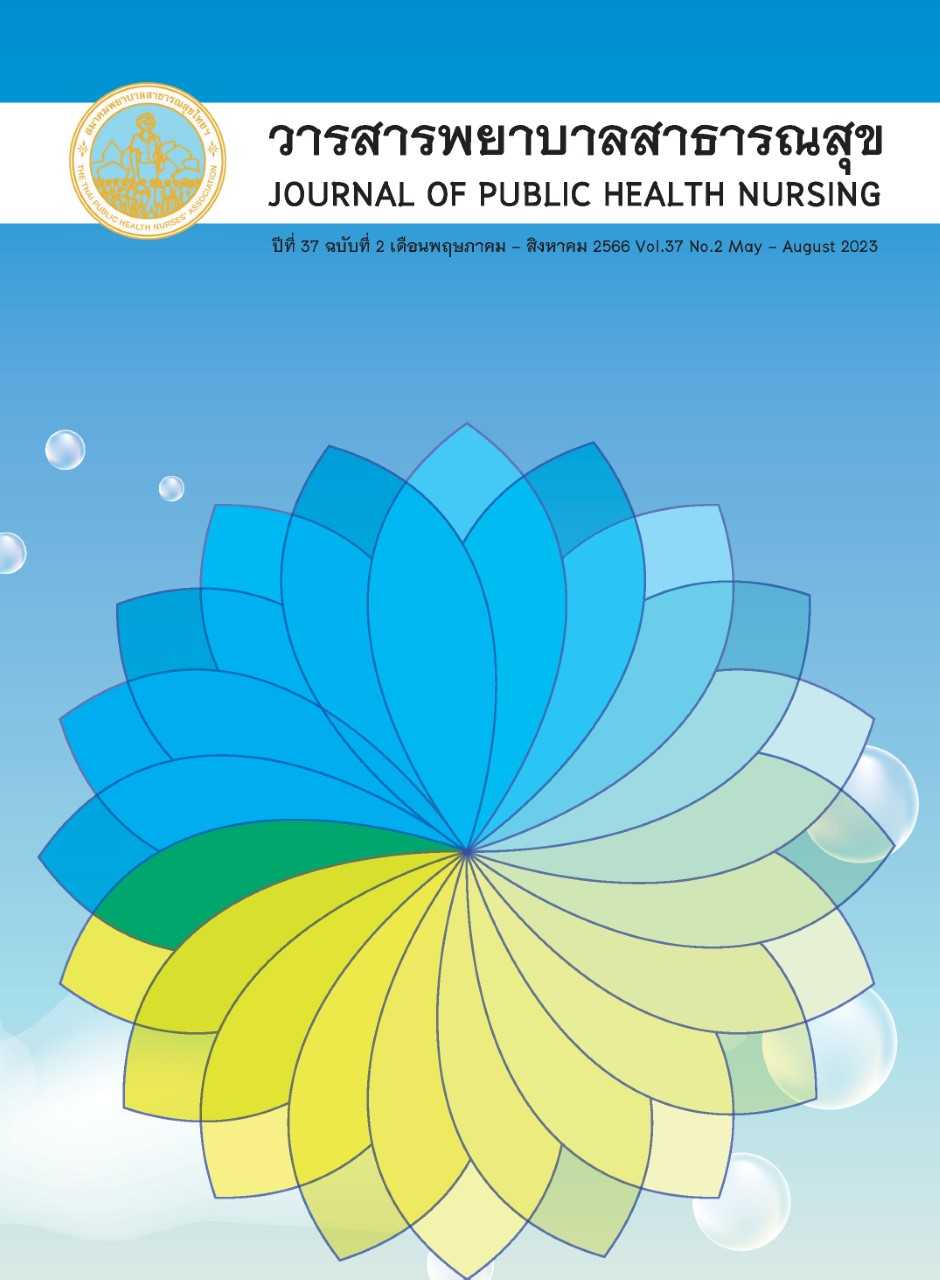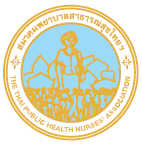Prevalence and Related Factors to Post-Traumatic Stress Disorder among Thai Nurses Exposed to the COVID-19 Pandemic
Keywords:
Post Traumatic Stress Disorder, NURSES, THE PANDEMIC OF COVID-19, Social support, ResilienceAbstract
Post-Traumatic Stress Disorder (PTSD) among Nurses Exposed to the COVID-19 Pandemic impacts on their well-being and quality of life. Therefore, it is of utmost importance. This study aims to determine the Prevalence and Related Factors to Post-Traumatic Stress Disorder among Thai Nurses Exposed to the COVID-19 Pandemic. The research design is a Cross-sectional survey. The study sample was 288 Thai registered nurses who provided care for patients at risk of or infected with Covid-19 during January to May 2020. The Snowball Sampling technique was used to recruit study samples. Data were collected by online questionnaires using QR code format and analyzed by descriptive statistics such as percent, mean, standard deviation as well as inferential statistics as Chi-square, simple and multiple Logistic regression analysis.
The results shown that most of the study sample were female (93.8%) with an average age of 37.30 years old (S.D. = 9.68). The prevalence to Post-Traumatic Stress Disorder among Thai Nurses Exposed to the COVID-19 Pandemic were 20.8%. The factors that associated with PTSD were the followings: 1) resilience: it was found that those who have low level of resilience were more likely to have PTSD (OR = 2.01, 95% CI = 1.08-3.74), 2) shift work: nurses who have shift work were 1.96 times at higher risk of developing PTSD (OR = 1.96, 95% CI = 1.05-3.69), 3) job stress: the high strain nurses were 2.6 times at risk of developing PTSD (OR = 2.59, 95%CI = 1.29-5.20), and 4) low social support was more likely to develop PTSD (OR = 3.15, 95% CI = 1.36-7.28). Analyzed by Multiple Logistic Regression Analysis. The factors that associated with PTSD were the followings: 1) job stress: the high strain nurses were 2.5 times at risk of developing PTSD (OR = 2.51, 95%CI = 1.21-5.19) and 2) low social support was more likely to develop PTSD (OR = 2.73, 95%CI = 1.14-6.57).
Suggestion was the relevant stakeholders can use the results from this study to provide mental health services such as resilience building clinic, stress management program, as well as facilitate and support safe working environment for nurses and medical personnel particularly when working in emergency medical situations in the future.
References
WHO COVID-19 Dashboard. Geneva: World Health Organization (Internet). 2020 (cited 2020 September 1). Available from: https://covid19.who.int/
WHO COVID-19 Dashboard. Geneva: World Health Organization (Internet). 2023 (cited 2023 March 18). Available from: https://covid19.who.int/
Department of disease control ministry of public health. Coronavirus disease (COVID-19) Situation report (Internet). 2020 (cited 2020 September 1). Available from: https://ddc.moph.go.th/viralpneumonia/index.php
Paritta Wangkiat. The number of healthcare personnel infected with COVID-19 is increasing daily due to a shortage of protective equipment (Internet). 2020 (cited 2020 April 18). Available from: https://www.hfocus.org/content/2020/04/18981
Thailand Nursing and Midwifery Council. The declaration of Thailand Nursing and Midwifery Council: Coronavirus disease (COVID-19) Situation (Internet). 2021 (cited 2021 July 27). Available from: https://www.tnmc.or.th/news/620
Lai J, Ma S, Wang Y, Cai Z, Hu J, Wei N, Wu J, Du H, Chen T, Li R, Tan H, Kang L, Yao L, Huang M, Wang H, Wang G, Liu Z, Hu S. Factors Associated with Mental Health Outcomes Among Health Care Workers Exposed to Coronavirus Disease 2019. JAMA Network Open. 2020;3(3). Retrieved May 29, 2020, from https://jamanetwork.com/journals/jamanetworkopen/fullarticle/2763229.
Thai PBS news. WHO interview "Nurse" The first COVID-19 patient in Thailand is admitted (Internet). 2020 (cited 2020 June 20). Available from: https://news.thaipbs.or.th/content/291499
Huang JZ, Han MF, Luo TD, Ren AK, Zhou XP. Zhonghua lao dong wei sheng zhi ye bing za zhi = Zhonghua laodong weisheng zhiyebing zazhi = Chinese journal of industrial hygiene and occupational diseases. 2020;38(3):192-195. doi: 10.3760/cma.j.cn121094-20200219-00063.
Rossi R, Socci V, Pacitti F, Di Lorenzo G, Di Marco A, Siracusano A, et al. Mental health outcomes among front- and second-line health workers associated with the COVID-19 pandemic in Italy. Retrieved May 29, 2020, from https://jamanetwork.com/journals/jamanetworkopen/fullarticle/2766378.
Koh D. 9 Occupational health aspects of emerging infections – SARS outbreak affecting healthcare workers. Occupational & Environmental Medicine. 2018. Retrieved June 1, 2020, from https://oem.bmj.com/content/75/Suppl_2/A14.1.
Jung H, Jung SY, Lee MH, et al. Assessing the Presence of Post-Traumatic Stress and Turnover Intention Among Nurses Post–Middle East Respiratory Syndrome Outbreak: The Importance of Supervisor Support. SAGE Public Health Emergency Collection. 2020; March. Available from: https://www.ncbi.nlm.nih.gov/pmc/articles/PMC7201205/. Accessed June 1, 2020.
Chong MY, Wang WC, Hsieh WC, Lee CY, Chiu NM, Yeh WC, Huang OL, Wen JK, Chen CL. Psychological impact of severe acute respiratory syndrome on health workers in a tertiary hospital. The British journal of psychiatry: the journal of mental science. 2004;185:127-133. doi: 10.1192/bjp.185.2.127.
Gonzalo Salazar de Pablo et al. "Impact of Coronavirus syndromes on Physical and Mental Health of Health care Workers: Systematic Review and Meta-analysis." Journal of Affective Disorders, June 2020. Retrieved July 3, 2020, from https://scholar.google.com/citations?user=6mdAX0wAAAAJ&hl=en#d=gs_md_cita-d&u=%2Fcitations%3Fview_op%3Dview_citation%26hl%3Den%26user%3D6mdAX0wAAAAJ%26citation_for_view%3D6mdAX0wAAAAJ%3ALkGwnXOMwfcC%26tzom%3D-420.
Thamakaison S. PTSD (Post-Traumatic Stress Disorder). (Internet). 2020 (cited 2020 June 2). Available from: https://www.rama.mahidol.ac.th/ramachannel/home/article/ptsd-%E0%B8%A0%E0%B8%B2%E0%B8%A7%E0%B8%B0%E0%B8%9B%E0%B9%88%E0%B8%A7%E0%B8%A2%E0%B8%97%E0%B8%B2%E0%B8%87%E0%B8%88%E0%B8%B4%E0%B8%95%E0%B8%88%E0%B8%B2%E0%B8%81%E0%B9%80%E0%B8%AB%E0%B8%95%E0%B8%B8/.
Hosseininejad SM, Jahanian F, Elyasi F, Mokhtari H, Koulaei ME, Pashaei SM. The prevalence of post-traumatic stress disorder among emergency nurses: a cross-sectional study in northern Iran. BioMedicine. 2019;9(3):26-31. Retrieved June 3, 2020, from https://www.researchgate.net/publication/335431486_The_prevalence_of_post-traumatic_stress_disorder_among_emergency_nurses_a_cross_sectional_study_in_northern_Iran.
Nisulaida Nisoh, Sukhontha Siri, Dusit Sujirarat, Surintorn Kalampakorn & Nopporn Tantirangsee. Posttraumatic Stress Disorder Symptoms in Public Health Personnel Working in the Area of Three Southern Border Provinces (Internet). 2004 (cited 2020 June 3). Available from: https://www.ph.mahidol.ac.th/phep/%E0%B8%99%E0%B8%B4%E0%B8%AA%E0%B8%B8%E0%B9%84%E0%B8%A5%E0%B8%94%E0%B8%B2%20%20%E0%B8%99%E0%B8%B4%E0%B9%82%E0%B8%8B%E0%B8%B0_Oral.pdf
Tortella-Feliu M, Fullana MA, Pérez-Vigil A, Torres X, Chamorro J, Littarelli SA, Solanes A, Ramella-Cravaro V, Vilar A, González-Parra JA, Andero R, Reichenberg A, Mataix-Cols D, Vieta E, Fusar-Poli P, Ioannidis JPA, Stein MB, Radua J, Fernández de la Cruz L. Risk factors for posttraumatic stress disorder: An umbrella review of systematic reviews and meta-analyses. Neuroscience and biobehavioral reviews. 2019;107:154-165. doi: 10.1016/j.neubiorev.2019.09.013.
McAllister M, McKinnon J. The Importance of Teaching and Learning Resilience in the Health Disciplines: A Critical Review of the Literature. Nurse Education Today. 2009;29:371-379. doi: 10.1016/j.nedt.2008.10.011.
Mealer M, Burnham EL, Goode CJ, Rothbaum B, Moss M. The prevalence and impact of post-traumatic stress disorder and burnout syndrome in nurses. Depress Anxiety. 2009;26(12):1118-1126. Retrieved June 4, 2020, from https://www.ncbi.nlm.nih.gov/pmc/articles/PMC2919801/.
Bamford M. Work and Health. 1st ed. Great Britain: Page Bros; 1995
Kaewboonchoo O. Occupational Health Nursing Practice: Health and Work Environment Assessment Health Project Planning. 1st ed. Bangkok: Danext Interco operation; 2018.
Jirapongsuwan A. Work Environment and Health Risks: Principles and Applications in Occupational Health Nursing. 1st ed. Bangkok: Danext Interco operation; 2018.
Daniel WW. Biostatistics: A foundation of analysis in the health science. USA: Wiley; 2005.
Tuntiseranee P, Arpakappakul N. Validation and modification of Karasek job stress questionnaire in Thai population. (Internet). 2005 (cited August 16, 2020). Available from: https://elibrary.trf.or.th/project_content.asp?PJID=RDG4430010.
Davidson JRT. Connor-Davidson Resilience Scale (CDRISC) Manual. Unpublished. 08-19-2018, accessible from www.cdrisc.com
Weiss DS, Marmar CR. The Impact of Event Scale - Revised. In: Wilson J, Keane TM, editors. Assessing psychological trauma and PTSD. New York: Guilford; 1996. p. 399-411.
Engel CC, Litz B, Magruder KM, Harper E, Gore K, Stein N, Yeager D, Liu X, Coe TR. Delivery of self-training and education. In: Textbook of Military Medicine: Psychiatric Issues in Combat and Noncombat Operations. Washington (DC): Office of The Surgeon General, Borden Institute; 2015. p. 103-126.
Somville FJ, De Gucht V, Maes S. The impact of occupational hazards and traumatic events among Belgian emergency physicians. Scand J Trauma Resusc Emerg Med. 2016;24:59. doi:10.1186/s13049-016-0249-9.
Pajonk FG, Cransac P, Müller V, Teichmann A, Meyer W. Trauma and stress-related disorders in German emergency physicians: the predictive role of personality factors. Int J Emerg Ment Health. 2012;14(4):257-268.
Baas MAM, Scheepstra KWF, Stramrood CAI, Evers R, Dijksman LM, van Pampus MG. Work-related adverse events leaving their mark: a cross-sectional study among Dutch gynecologists. BMC Psychiatry. 2018;18(1):73. doi:10.1186/s12888-018-1659-1.
Bar-Shai M, Klein E. Vulnerability to PTSD: Psychosocial and Demographic Risk and Resilience Factors. In: Safir M, Wallach H, Rizzo A, editors. Future Directions in Post-Traumatic Stress Disorder. Boston, MA: Springer; 2015. p. 1-20. doi:10.1007/978-1-4899-7522-5_1.
Molero Jurado M, Martos Martínez Á, Pérez-Fuentes M, et al. Job strain and burnout in Spanish nurses during the COVID-19: resilience as a protective factor in a cross-sectional study. Hum Resour Health. 2022;20:79. doi:10.1186/s12960-022-00776-3.
Babapour AR, Gahassab-Mozaffari N, Fathnezhad-Kazemi A. Nurses' job stress and its impact on quality of life and caring behaviors: a cross-sectional study. BMC Nurse. 2022;21:75. doi:10.1186/s12912-022-00852-y.
Mark G, Smith AP. Occupational stress, job characteristics, coping, and the mental health of nurses. Br J Health Psychol. 2012;17:505-521. doi:10.1111/j.2044-8287.2011.02051.x.
Tubbert SJ. Resiliency in Emergency Nurses. Journal of emergency nursing. 2016;42(1):47-52. doi:10.1016/j.jen.2015.05.016.
Guo YF, Luo YH, Lam L, Cross W, Plummer V, Zhang JP. Burnout and its association with resilience in nurses: A cross-sectional study. Journal of clinical nursing. 2018;27(1-2):441-449. doi: 10.1111/jocn.13952.
Maunder RG, et al. Applying the Lessons of SARS to Pandemic Influenza: An Evidence-based Approach to Mitigating the Stress Experienced by Healthcare Workers. [Internet]. 2008 [cited July 19, 2020]. Available from: https://link.springer.com/content/pdf/10.1007/BF03403782.pdf.
Nakhonsawan Rajanagarindra Psychiatric Hospital. How to adapt and overcome this difficult period. [Internet]. 2019 [cited February 24, 2023]. Available from: https://nph.go.th/?p=5675.
Hunter B, Warren L. Investigating Resilience in Midwifery: Final report. Cardiff University: Cardiff; 2013.
Department of Mental Health Service Administration. Handbook for Psychosocial Care of Health Personnel during the COVID-19 Crisis. (Internet). 2020 (cited April 18, 2023). Available from: https://mhtech.dmh.moph.go.th/page/subject_details.php?subject_id=205.
Su TP, Lien TC, Yang CY, Su YL, Wang JH, Tsai SL, Yin JC. Prevalence of psychiatric morbidity and psychological adaptation of the nurses in a structured SARS caring unit during outbreak: A prospective and periodic assessment study in Taiwan. Psychiatric Research. 2007;41(1-2):119-130. Retrieved May 30, 2020, from https://pubmed.ncbi.nlm.nih.gov/16460760/.
Li YX, Wang YC, Lv XY, Li R, Guan XY, Li L, Li JL, Cao YJ. Effects of Factors Related to Shift Work on Depression and Anxiety in Nurses. Frontiers in Public Health. 2022;10:926988. doi: 10.3389/fpubh.2022.926988.
Institute of Neurology, Department of Medical Services. Post-Traumatic Stress Disorder (PTSD): Emotional Abnormalities Occurring after Experiencing Violent Events. (Internet). 2022 (cited February 27, 2023). Available from: https://pr.moph.go.th/index.php?url=pr/detail/2/02/179609/.
Downloads
Published
How to Cite
Issue
Section
License
Copyright (c) 2023 Thai Public Health Nurses Association

This work is licensed under a Creative Commons Attribution-NonCommercial-NoDerivatives 4.0 International License.
บทความที่ตีพิมพ์และแผนภูมิรูปภาพถือเป็นลิขสิทธิ์ของวารสารพยาบาลสาธารณสุข (Thai Public Health Nurses Association)







